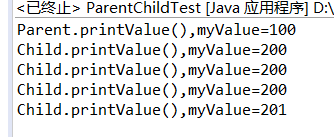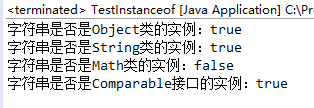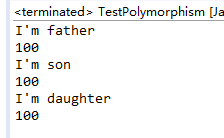一、今日学习内容
动手动脑
1.
class Mammal{} class Dog extends Mammal {} class Cat extends Mammal{} public class TestCast { public static void main(String args[]) { Mammal m; Dog d=new Dog(); Cat c=new Cat(); m=d; //d=m; d=(Dog)m; //d=c; c=(Cat)m; } }
d=m错误:不能从Mammal类转换到Dog类;
d=c错误:不能从Cat类转换到Dog类;
c=(Cat)m正确:
2.
public class ParentChildTest { public static void main(String[] args) { Parent parent=new Parent(); parent.printValue(); Child child=new Child(); child.printValue(); parent=child; parent.printValue(); parent.myValue++; parent.printValue(); ((Child)parent).myValue++; parent.printValue(); } } class Parent{ public int myValue=100; public void printValue() { System.out.println("Parent.printValue(),myValue="+myValue); } } class Child extends Parent{ public int myValue=200; public void printValue() { System.out.println("Child.printValue(),myValue="+myValue); } }

原因:
前两行正常输出,父类对象调用父类的方法,子类对象调用子类的方法;
第三行,当子类与父类拥有一样的方法,并且让一个父类变量引用一个子类对象时,到底调用哪个方法,由对象自己的“真实”类型所决定;
第四行,当parent=child;仅仅是将parent中有的方法用child的方法代替,所以parent.myValue++;而输出的是child的printValue(),而printValue()方法中输出的是child.myValue,所以输出的是child.myValue;
第五行,强制类型转换,++作用在child的myValue,所以输出的也是child的myValue,而不是parent的myValue;
结论:
当子类与父类拥有一样的方法,并且让一个父类变量引用一个子类对象时,到底调用哪个方法,由对象自己的“真实”类型所决定,这就是说:对象是子类型的,它就调用子类型的方法,是父类型的,它就调用父类型的方法。这个特性实际上就是面向对象“多态”特性的具体表现。如果子类与父类有相同的字段,则子类中的字段会代替或隐藏父类的字段,子类方法中访问的是子类中的字段(而不是父类中的字段)。如果子类方法确实想访问父类中被隐藏的同名字段,可以用super关键字来访问它。如果子类被当作父类使用,则通过子类访问的字段是父类的!
3.在子类中,若要调用父类中被覆盖的方法,可以使用super关键字。
class test{ void play() { System.out.println("我是父类test"); } } class test11 extends test{ void play() { super.play(); } } public class test1 { public static void main(String[] args) { test11 t=new test11(); t.play(); } }

4.
package Test; public class TestInstanceof { public static void main(String[] args) { //声明hello时使用Object类,则hello的编译类型是Object,Object是所有类的父类 //但hello变量的实际类型是String Object hello = "Hello"; //String是Object类的子类,所以返回true。 System.out.println("字符串是否是Object类的实例:" + (hello instanceof Object)); //返回true。 System.out.println("字符串是否是String类的实例:" + (hello instanceof String)); //返回false。 System.out.println("字符串是否是Math类的实例:" + (hello instanceof Math)); //String实现了Comparable接口,所以返回true。 System.out.println("字符串是否是Comparable接口的实例:" + (hello instanceof Comparable)); String a = "Hello"; //String类既不是Math类,也不是Math类的父类,所以下面代码编译无法通过 //System.out.println("字符串是否是Math类的实例:" + (a instanceof Math)); } }

5.
package second; class Parent { public int value=100; public void Introduce() { System.out.println("I'm father"); } } class Son extends Parent { public int value=101; public void Introduce() { System.out.println("I'm son"); } } class Daughter extends Parent { public int value=102; public void Introduce() { System.out.println("I'm daughter"); } } public class TestPolymorphism { public static void main(String args[]) { Parent p=new Parent(); p.Introduce(); System.out.println(p.value); p=new Son(); p.Introduce(); System.out.println(p.value); p=new Daughter(); p.Introduce(); System.out.println(p.value); } }

二、遇到的问题
没有遇到问题
三、明日计划
明天完成Javaweb相关方面的配置,上次配置没有配置好